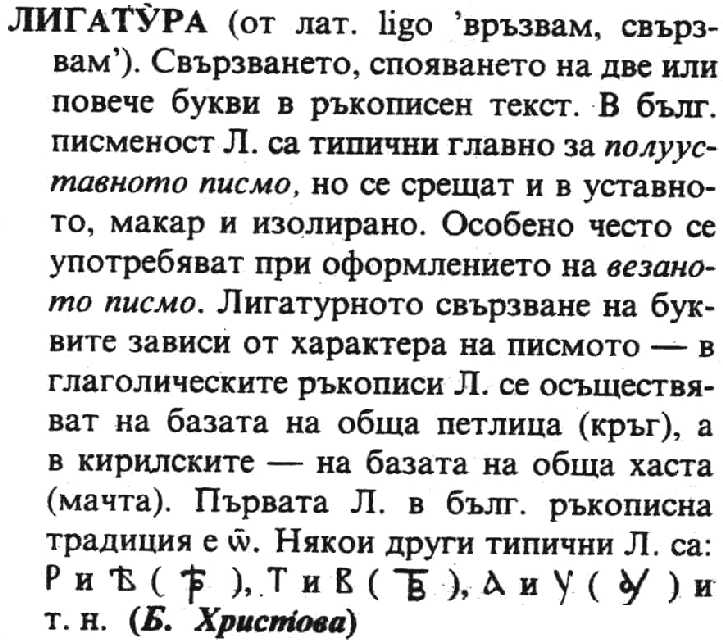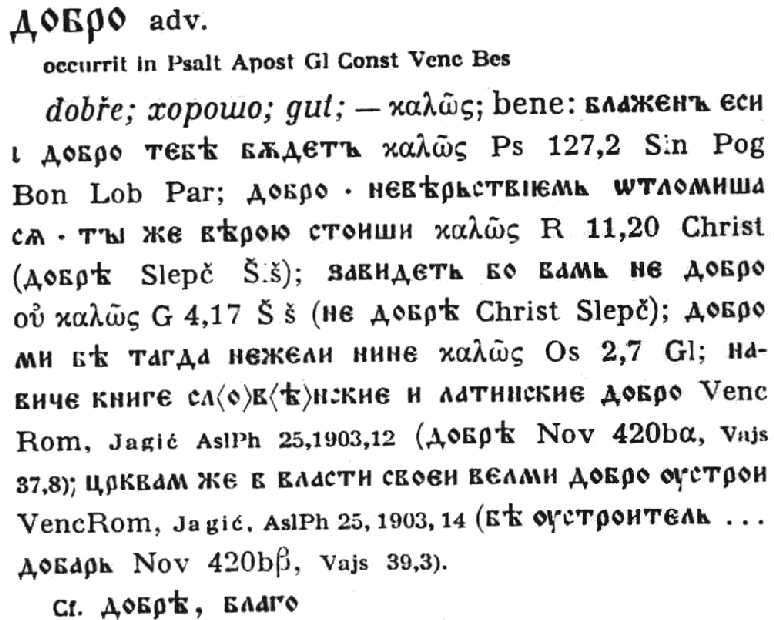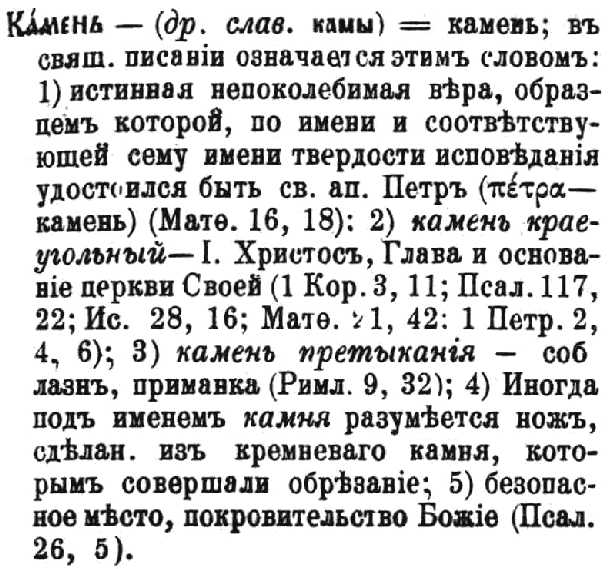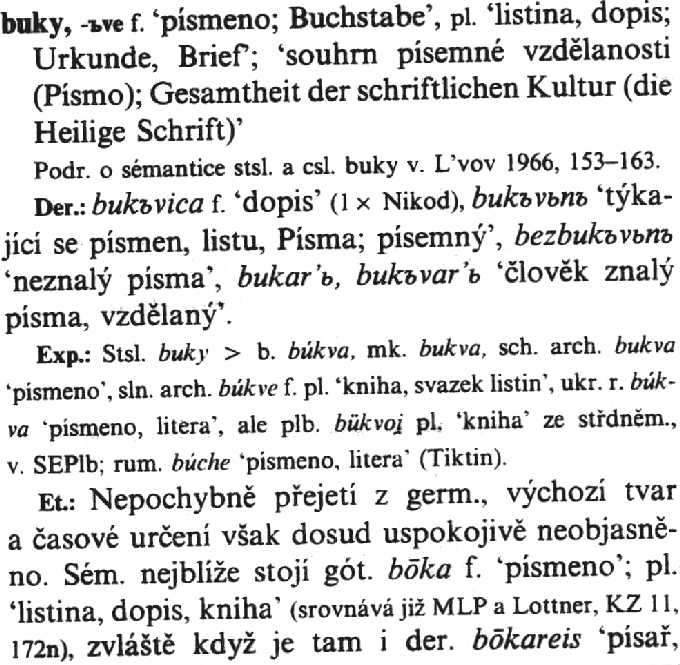
Reference works found on this page include works regardless of the language of publication about Old Church Slavic and Old Church Slavonic, which are two different names for the same entity. This language is sometimes referred to as Old Bulgarian as well. Publications on the later language of Church Slavic are also included here. Resources about Slavic linguistics, proto-Slavic/Common Slavic, or other Slavic languages will appear on the pages devoted to the individual languages or the General Resources for Slavic Linguistics page. Many of the resources annotated there will contain information about OCS, so you should peruse them too. Since OCS is classified as a South Slavic language, the section devoted to South Slavic Linguistics, which appears in the General Resources for Slavic Linguistics page, may also be of interest for this category. Some cross references are provided for works that could be listed under multiple categories.
There is a web tool that can help you simplify your work with documents in Old Church Slavonic — an online OCS keyboard available at http://www.churchslavonic.org.
Bibliographies
When you search an online catalog using subject words such as “Church Slavic” and “bibliography,” the results may surprise you. Rather than getting bibliographies of works about Church Slavic, you will get bibliographies of works printed in Church Slavic or OCS. Many of these bibliographies describe collections of manuscripts or printed books that are housed in one particular institution. Others cover Church Slavic or OCS imprints from a defined time period. (These works will be described in a future section on Archives since these materials pertain to unique manuscripts rather than published materials). There are relatively few monographic bibliographies of works about CS/OCS. To find these kinds of materials you need a different strategy. Namely, you should look at bibliographies of slavistics or Slavic linguistics for many of them contain sections devoted to CS/OCS. Many are listed in the General Resources for Slavic Linguistics. Also, see the section below on Cyril-Methodian studies because the works listed there contain citations for books and articles about CS/OCS. There is also an older bibliography described below which contains some works on the topic. The second item in this category is a bibliography of Church Slavic and 16th-17th century works and the related microfilm set. For materials on OCS/CS that were published between 1825 and 1880, see vyp.3 of Bibliograficheskii ukazatel’ literatury po russkomu iazykoznaniiu.
Literatura izsliedovanii o tserkovnoslavianskom i russkom iazykakh na inostrannykh iazykakh: s XVI vieka po 1872 god…
Balitskii, Ivan Ivanovich. Kiev: V tip. Kievopecherskoi uspenskoi lavry, 1876. 60, 83 p.
U of I Library Call Number: International & Area Studies Russian Reference (Slavic) 016.49181701 B19l
This annotated bibliography provides citations for grammars and textbooks on Russian and Church Slavic published between the 16th century and 1872. The entries in this bibliography are arranged into 2 separate sections and presented chronologically by publication date within each section. The first section lists works published in foreign languages and the second section contains works published in Russian or Slaviano-Russian. Many of the annotations are extensive, lasting several pages in length. Others are quite short. See the entry below as an example of a short annotation.


Knigi kirillovskoi pechati izdannye v Moskve v XVI-XVII vekakh. Svodnyi katalog.
Zernova, A.S. Moskva: Gos. Ordena Leninina Biblioteka SSSR, 1958.
U of I Library Call Number: International & Area Studies Russian Reference (Slavic) and Main Stacks 015.47 Z54k + History, Philosophy & Newspaper Film 281.947 C685 reels 1-315
Russian and Church Slavic books, most of a religious nature, published in the 16th and 17th centuries in Moscow are the subject of this bibliography and microfilm set. The entries for 498 books are arranged by publisher and then by date and provide detailed information about the number of pages, illustrations, name of the tsar and patriarch under whose reign the book was issed, the height of the script, and other details relevent to the description of rare materials. This source is also a union catalog so it shows which libraries in Russia hold copies of these works. But the microfilm set reproduces all of the items, so a trip to Russia is unnecessary unless you need to see the originals. Jot down the number of the entry because you will need it to find the correct reel of microfilm. Each reel lists on the box the item numbers that it contains. There are indexes for ornaments and editions in the bibliography. See the entry below for a Psalter from 1615.
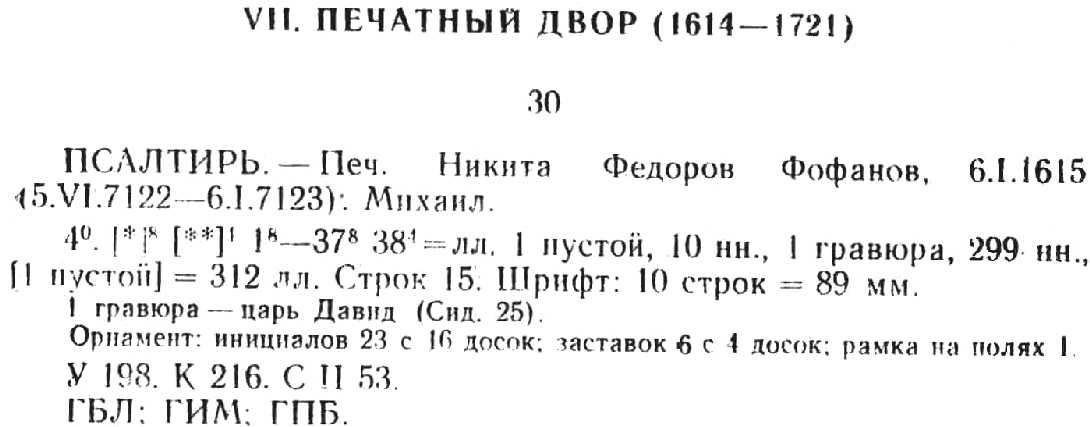
Encyclopedias
Besides the works listed below another source that has works relevant to OCS and CS is the first volume of Slovar’ knizhnikov i knizhnosti Drevnei Rusi which is annotated on the page devoted to resources for the study of Russian Literature.
Kirilo-Metodievska entsiklopediia v tri toma.
Dinekov, Petur. Sofiia: BAN, 1985-2003. 3 vols.
U of I Library Call Number: International & Area Studies Bulgarian Reference (Slavic) 037.811 K634 [UIUC has v.1-2]
Produced by the Bulgarian Academy of Sciences, this scholarly encyclopedia presents signed articles on all aspects of Old Church Slavic philology. Many of the articles are extensive, covering over 10 pages, and all have bibliographical references. They include entries on famous scholars, religious and historical figures, on codices and other written monuments, on places and nations, on linguistic phenomena, alphabets, and each letter of the alphabet, among other topics. All entries are written in Bulgarian. The set is also amply illustrated with both color and black and white photos, charts, and maps. Follow the link for the entry on Anton Sem’enovich Budilovich, a Russian Slavist who published works on OCS.

Starobulgarska literatura. Entsiklopedichen rechnik.
Petkanova, Donka. Sofiia: Izd-vo “Petur Veron, 1992. 519 p.
U of I Library Call Number: International & Area Studies Bulgarian Reference Slavic 891.81703 P445s
In this one-volume encyclopedia topics relating to Bulgarian literature and Old Church Slavic (also known as Old Bulgarian) literature are addressed. The span of coverage is the 7th through the beginning of the 18th centuries. Articles elucidate different areas of the discipline such as biographies of important people from the time (Kliment Okhridskii, Methodius, etc.), significant manuscripts or written monuments (Savina kniga, Codex Zographensis, etc.), and types of monuments (musical pieces, minei/menaion, etc.), among other topics. Most articles, all of which are written in Bulgarian, contain bibliographical references and are signed by the scholars who wrote them. They range in length from one paragraph to several pages. Articles pertaining to OCS topics are interspersed with those that present Bulgarian topics. There is a glossary of special terms at the back of the encyclopedia. See the entry at the left on ligatures.

Dictionaries
Slovnik jazyka staroslovenskeho. Lexicon linguae palaeoslovenicae.
Ceskoslovenska Akademie ved. Praha: Academia, 1966-1997. 52 vols.
U of I Library Call Number: International & Area Studies General Slavic Reference (Slavic) Q. 491.81701 C337s v.1-52
Compiled by the Czech Academy of Sciences, this major dictionary of Old Church Slavic is now complete in 52 volumes. Prefatory materials, which appear in the first volume, introduce the dictionary and describe the OCS texts from which the lexicon is extracted, as well as presenting information about those texts in a chart. The entries provide grammatical information, definitions in Czech, Russian, German, Greek and Latin, notations that show in which documents the word appears, and passages with references to show how it was used. See the entry above for the adverb “dobro.”

Staroslavianskii slovar’ (po rukopisiam X-XI vekov).
Tseitlin, R.M. ed., et al. Moskva: Russkii iazyk, 1994. 842 p.
U of I Library Call Number: International & Area Studies General Slavic Reference (Slavic) 491.8170103 St28
This work is a dictionary of OCS in one handy volume which contains over 10,000 words that were extracted from 18 Slavic texts of the 10th and 11th centuries. It was compiled jointly by the Czech and Russian Academies of Sciences. The introduction contains descriptions of the texts and an article on earlier attempts at OCS lexicography. Entries provide grammatical details, definitions in Russian, Czech and Greek as well as cited passages. At the end of the book are morphological tables which show various grammatical paradigms. See the entry for the adverb “dobro” and compare it to the one from the 52-volume dictionary described above.


Polnyi tserkovno-slavianskii slovar’ (so vneseniem v nego vazhnieishikh drevne-russkikh slov i vyrazhenii)…
D’iachenko, Grigorii. Moskva: Izdatel’skii Otdel Moskovskogo Patriarkhata, 1993. 1120 p.
U of I Library Call Number: International & Area Studies Russian Reference (Slavic) 491.8170103 D54p
HathiTrust full text (1899 edition):
Vol. 1: http://hdl.handle.net/2027/inu.30000011356106
Vol. 2: http://hdl.handle.net/2027/inu.30000011356270
This dictionary is a reprint of one that was published in 1899. It contains over 30,000 words from Church Slavic and Old Russian. Entries provide definitions in Russian, often a related Greek form, indications of the language of derivation if applicable, and references to the biblical passages in which the word is found. Don’t overlook the “pribavlenie” at the end of the book, for it contains over 200 additional pages of entries. The detailed introduction introduces the reader to other monuments of Slavic and Church Slavic lexicography as well as the issues related to the compilation of such a work. See the entry on the left for the word “kamen’.”

Etymologicky slovnik jazyka staroslovenskeho.
Havlova, Eva, ed. et al. Praha: Nakladatelstvi Ceskoslovenske Akademie Ved, 1989-
U of I Library Call Number: International & Area Studies General Slavic Reference (Slavic) Q.491.8170103 Et94 v.1-11
Produced by the Czech Academy of Sciences, this etymological dictionary of OCS is still being published with v.11 as the latest (up through the word poditi ). Entries contain definitions in Czech and German, grammatical information, variants of the word, derivative forms (appears after the abbreviation Der.), etymologies with references to sources (appears after the abbreviation Et.), and sometimes a section that posits the expansion of the OCS word into other languages (appears after the abbreviation Exp.). The list of sources occurs in the first volume with supplementary lists in subsequent volumes. See the image on the right for the beginning of the entry on “buky.”

Old Church Slavonic (Old Bulgarian)-Middle Greek-Modern English dictionary.
Lysaght, T.A. Wien: Verlag Bruder Hollinek, 1983. 471 p.
U of I Library Call Number: Main Stacks Q.491.81701 L996o
The only dictionary for OCS that has definitions in English, this resource also provides Middle Greek forms. It covers the language of the 10th-11th centuries and is based on the canonical textual monuments such as codices Marianus, Suprasliensis, and Zographensis among others. A complete list of the texts used can be found in the prefatory materials. Entries provide grammatical information, a definition, Greek forms and references to biblical passages as well as to the texts in which the word can be found. See the image below for a sample of the entries.
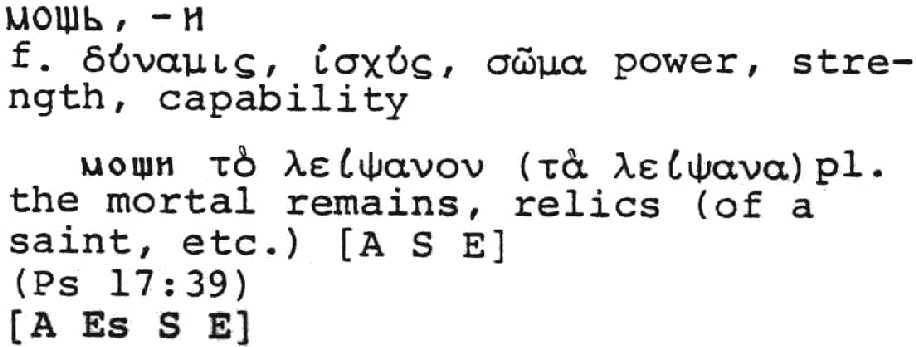

Handworterbuch zu den Altkirchenslavischen Texten.
Sadnik, L. und R. Aitzenmuller. Heidelburg: Carl Winter, 1955. 341 p.
U of I Library Call Number: Internationl & Area Studies General Slavic Reference (Slavic), Main Stacks, and Oak Street Facility 491.817 Sa1h
This brief dictionary of OCS provides German definitions of words used in the major OCS written monuments. Entries show some grammatical forms and the part of speech, as well as a German gloss and notations as to which text the word appears in. The second part of the dictionary is a reverse dictionary of the same words which can be helpful for identifying words that have the same derivational suffixes. The third part offers a short etymology and citations to the literature in which the user can read more on the derivation of a particular OCS word. See the entry below from part 3 for the word “igo.”
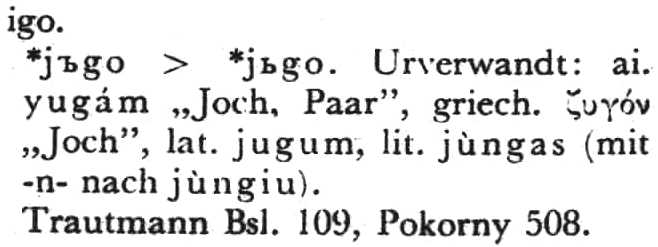

Spravochnyi i ob”iasnitel’nyi slovar’ k psaltiri.
Gil’tebrandt, P. A. Sankt-Peterburg: Sinodal’naia tipografiia, 1898. 549 p.
U of I Library Call Number: Main Stacks 223.2 G42s
This is a dictionary of words that appear in the Church Slavic Psalter. Entries include Greek and Latin equivalents with definitions in Russian and Psalm numbers to locate the word in the Psalter. There are also abbreviations that indicate from which sources the compiler extracted certain definitions or forms. The list of sources appears in the introduction. At the back of the book is an index of Greek-Slavic-Latin-Russian. In this index one can look up the Greek word and find the equivalents in the other languages. Unfortunately, Greek is the only accessible language in the index, thus one cannot start with a Latin word and find the equivalents in the other languages. See the entry on the right for the word “paguba.” The lexicographer Petr Andreevich Gil’tebrandt also compiled a Church Slavic dictionary of words that appear in the New Testament ( Spravochnyi i ob”iasnitel’nyi slovar’ k Novomu Zavetu , 1882-1885), but the University of Illinois does not own this work.
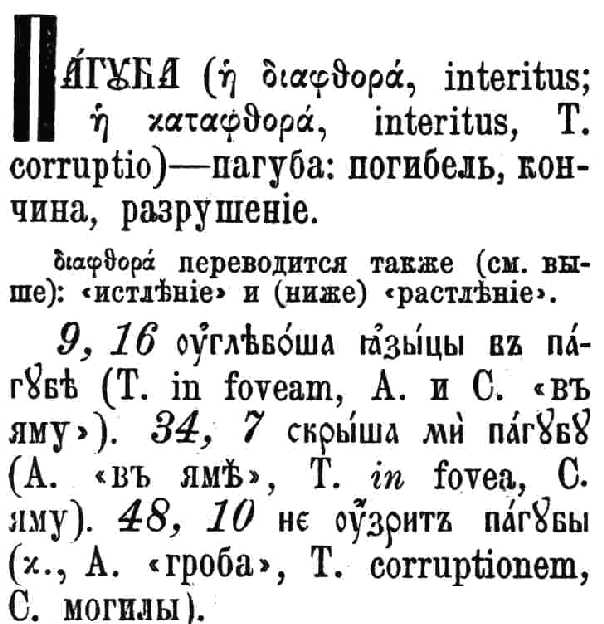
Another source of potential interest to those studying OCS is Rechnik na starobulgarski dumi v dneshnite bulgarski govori which is annotated on the page devoted to Resources for Bulgarian Linguistics. A recent acquistion for the University of Illinois library is volume one of a new Old Bulgarian (i.e. OCS) dictionary which comes from the Bulgarian Academy of Sciences, Institute za bulgarski ezik, Starobulgarski rechnik [U of I Library Call Number: Main Stacks 491.81701 St28 v.1].

Grammars
There are many grammars of OCS. Below are described just a few which are used commonly by universities in the USA. For much older ones see Literatura izsliedovanii o tserkovnoslavianskom i russkom iazykakh na inostrannykh iazykakh: s XVI vieka po 1872 god… which is glossed above. Many others are listed in the bibliographies annotated on the page for General Resources for Slavic Linguistics. A good subject heading for this type of resource is Church Slavic language–grammar.
Old Church Slavonic grammar.
Lunt, Horace G. The Hague: Mouton, 1974. 221 p.
U of I Library Call Number: Main Stacks 491.817 L97o
Lunt’s grammar provides a good introduction to the language. The grammar is presented in several sections: an introduction, the writing system, the sound system, declension, conjugation, syntax, and an epilogue. It has many helpful grammatical tables, a subject index, and an index of irregularities in conjugation. The tables are interspersed in the text rather than grouped together at the back of the book. A bibliography of works about various aspects of OCS appears at the end of the introduction. This bibliography includes citations for a number of other grammars of OCS.

Altkirchenslavische Grammatik mit einer Auswahl von Texten und einem Worterbuch.
Diels, Paul. Heidelberg: Carl Winters, 1932-1934. 2 vols.
U of I Library Call Number: Main Stacks and Oak Street Facility 491.817 D56a v.1-2
Although this grammar is written in German, it is still a very helpful resource for students of OCS. It is comprised of two parts: the grammar and a reader with a glossary. The grammar has an introduction, chapters on the writing system, the vowels, the consonants, substantives, adjectives, pronouns, verbs, and other parts of speech. There is an index of subjects and words for the grammar. The reader presents selected, annotated passages from OCS written monuments as well as a glossary with German equivalents. The key to abbreviations of cited literature serves as a handy bibliography of pre-1932 sources on OCS.
Bibliographies of Cyril-Methodian Studies
Cyril-Methodian studies encompasses all aspects of scholarship related to the topic of Cyril and Methodius, not just biographical information about the brothers. It also is concerned with old Slavic culture, with specific OCS manuscripts, with the political and historical situation of that time, and other such themes. There are a number of published bibliographies that present material on these topics. Below are annotated some that are held in the collection of the University of Illinois. Others can be found by searching WorldCat for the subject heading Church Slavic philology – bibliography.
Kirilometodievska bibliografiia 1940-1980.
Duichev, Iv. et al.Sofiia: Sofiiski universitet “Kliment Okhridski,” 1983. 723 p.
U of I Library Call Number: International & Area Studies General Slavic Reference (Slavic) and Oak Street Facility 016.491817 D88k
Besides providing over 5000 citations for books, articles, and reviews on the topic published between 1940-1980, this bibliography also has an introduction that surveys other Cyril-Methodian bibliographies. Citations in the body of the work are arranged into two sections: Bulgarian publications and non-Bulgarian publications which include items in all of the other Slavic languages plus English, French, German, and Greek among other languages. Within each of these two sections there are many subject categories such as bibliographies, sources for the history of Cyril and Methodius, the musical activity of Cyril and Methodius, the development of Slavic writing, the Cyril-Methodian tradition in the Slavic world, etc. An index for authors and a source list appear at the end of the book. See the image below for some of the citations which appear under the heading “sources for the life and activity of Kliment Okhridski.”
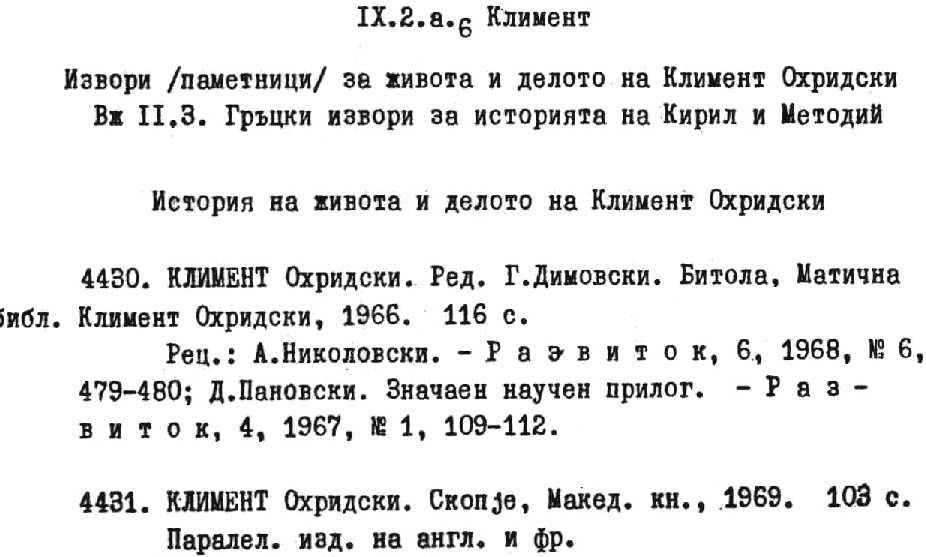

Kirilometodievska bibliografiia za 1934-1940 god.
Popruzhenko, M. Romanski, St. Sofiia: Durzhavna pechatnitsa, 1942. 169 p.
U of I Library Call Number: International & Area Studies Bulgarian Reference (Slavic) 016.491817 B87k
What differentiates this bibliography from the one above besides the variant dates of coverage is that this bibliography has excerpts that serve as annotations. It provides almost 900 citations for books, reviews, and articles on Cyril-Methodian studies from 1934-1940 and includes an excerpt from each piece in whatever language the piece is written that elucidates the contents of the work. Entries are arranged by subject such as bibliographies, Slavic alphabets, the Cyril-Methodian tradition in the Slavic world, grammars, written monuments of the Old Bulgarian (OCS) language, and others. The list of sources appears right after the introduction and the author index at the end. See the image below for some of the entries that appear under the heading “Slavic alphabets.”
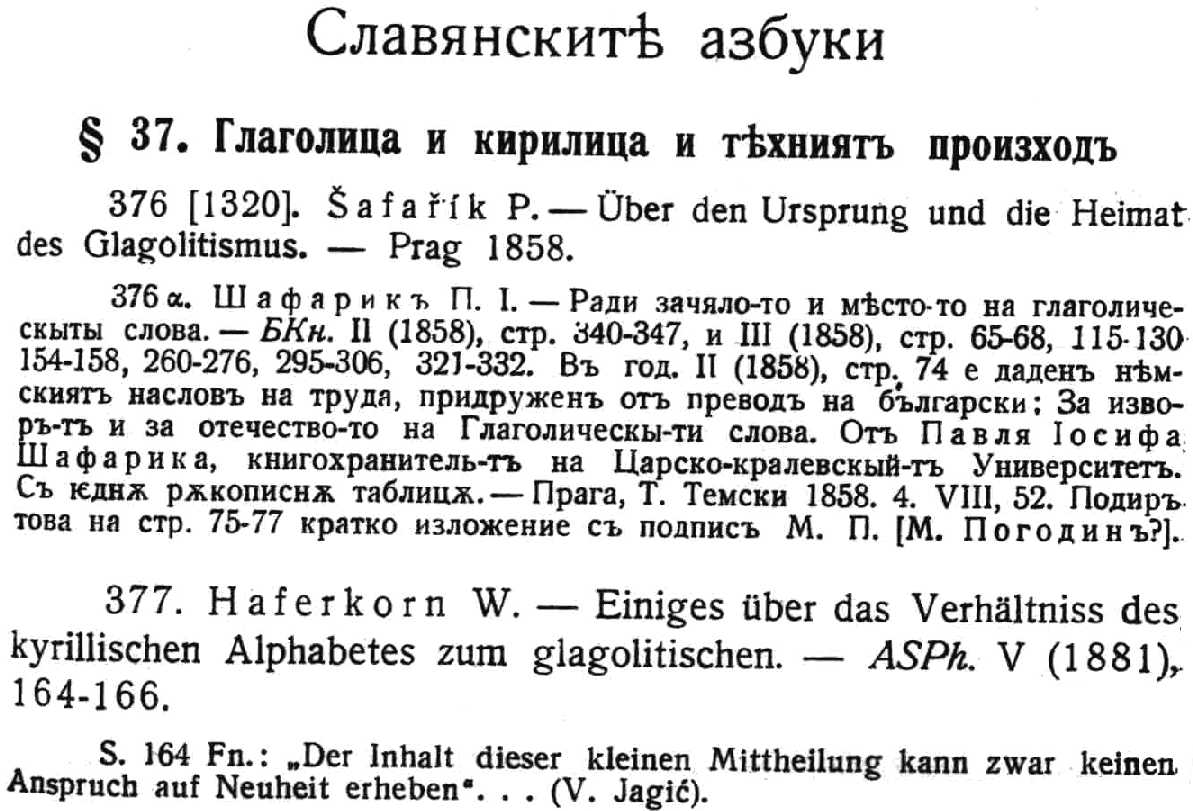

Opyt sistematicheskoi Kirillo-Mefod’evskoi bibliografii.
Il’inskii, G.A. Sofiia: Pechatnitsa P. Glushkov, 1934. 302 p.
U of I Library Call Number: Internationl & Area Studies Russian Reference (Slavic) and Oak Street Facility016.274367 Il5o
Il’inskii’s bibliography is similar in arrangement to the preceding two Cyril-Methodian bibliographies as it groups citations according to subjects relevant to the discipline. Examples of subjects include bibliographies, sources for the history of Cyril and Methodius, Slavic alphabets, Glagolitic monuments, translation of canonical books, etc. Use the detailed table of contents to locate other topics of interest. What is interesting about this bibliography is that it has a section on popular (vs. scholarly) literature which includes some citations from newspapers. Although the bibliography is not annotated, it does include almost 3400 citations for books and articles in all languages published from 1516-1933. In addition, there are also citations for almost 1000 reviews. The list of sources appears after the introductory materials, one of which is written in Russian and the other in Bulgarian. There is also an author index to provide better access to the material. See the image below for some citations that appear under the heading “chrestomathies.”
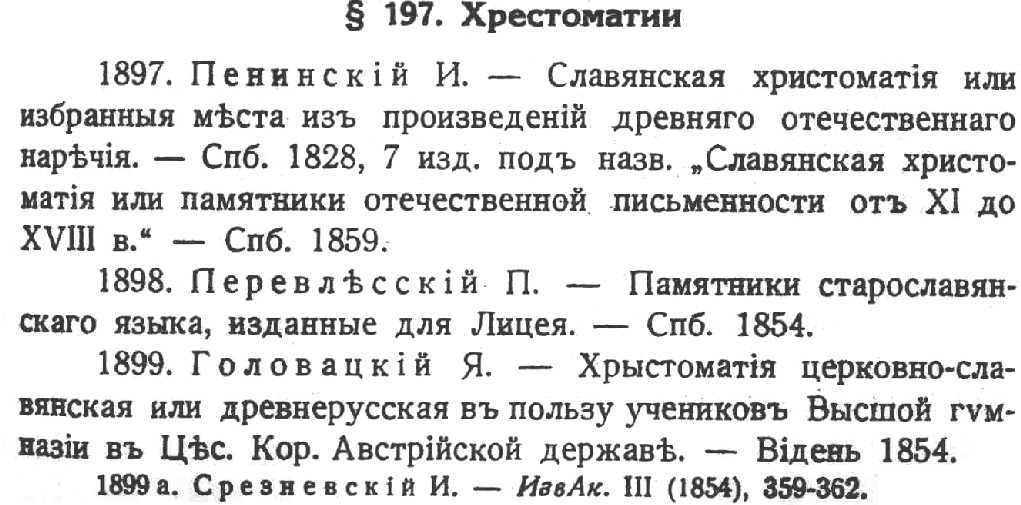

Kirilo-Metodievska bibliografiia 1516-1934.
Nikolova, Svetlina. Sofiia: BAN, 2003. 685 p.
U of I Library Call Number: International & Area Studies Bulgarian Reference (Slavic) 270.0922 K6341
Devoted to the great Russian scholar Grigorii Andreevich Il’inskii , this volume reprints his work Opyt sistematicheskoi kirillo-mefod’evskoi bibliografii which provides citations for almost 3400 works plus about 1000 reviews in the field of Cyril-Methodian studies published from 1516-1933. In addition, this volume contains reviews of Il’inski’s bibliography and Zheliazkova and Zafirova’s Bulgarian additions to Il’inskii’s bibliography from 1846-1934. Using archival sources and reproducing personal documents and letters, the introduction discusses Il’inskii’s life, including his arrest and execution, and his contributions to the field of Cyril-Methodian studies. Both bibliographies have name indexes and a list of sources and arrange the citations under the same categories. See the image below for the beginning of the table of contents of the Zheliazkova/Zafirova work.
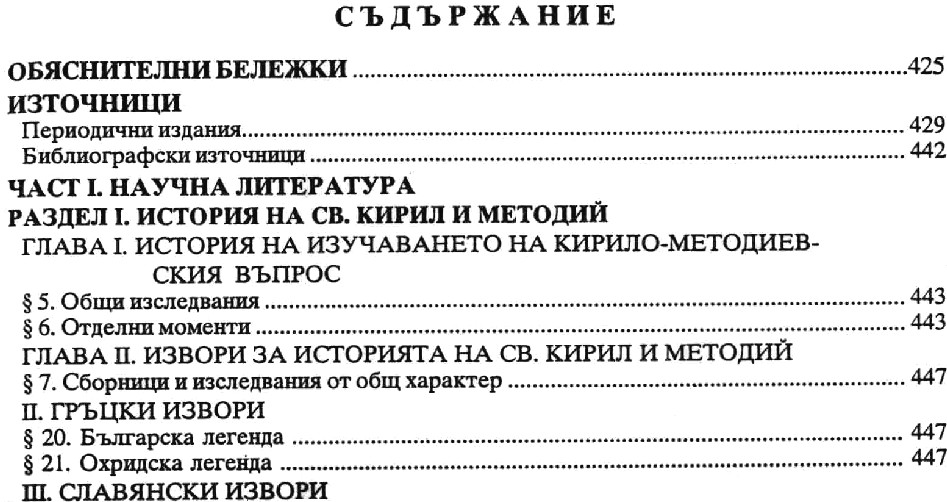
Subject Websites
There are a handful of websites devoted to the study of Church Slavic and Old Church Slavic. Many, however, are personal or religious pages which lack a well-defined scope or clear authority. Below we have listed just a few to get you started. Try searching some of the Slavic portals such as REESWeb to find others. A recent addition (2003) to this category is Bibliotheca Slavica compiled by scholars at the University of Sofia.
Corpus Cyrillo-Methodianum Helsingiense.
URL: http://www.slav.helsinki.fi/ccmh/
This site aims to provide a corpus of electronic versions of Old Church Slavic texts on the Internet. It is a project undertaken by the Slavonic and Baltic Department at the University of Helsinki. So far they have some of the major codices online (Marianus, Suprasliensis, e.g.) and link to other texts available on other sites. The texts are not in Cyrillic, but rather in 7-bit ASCII, which means that they cannot be read without the key to the symbols.

Kodeks.
URL: http://kodeks.uni-bamberg.de/
Created and maintained by a group of Slavic professors in Germany, this site is devoted to the medieval Slavic world, but it contains much information about OCS and Church Slavic. It has the various alphabets, information about the written monuments for OCS including brief bibliographies, links to electronic texts, some grammatical tables, links to related sites, and various fonts for download. Unfortunately, it appears that this site has not been updated recently.

Liturgical texts

![]()
